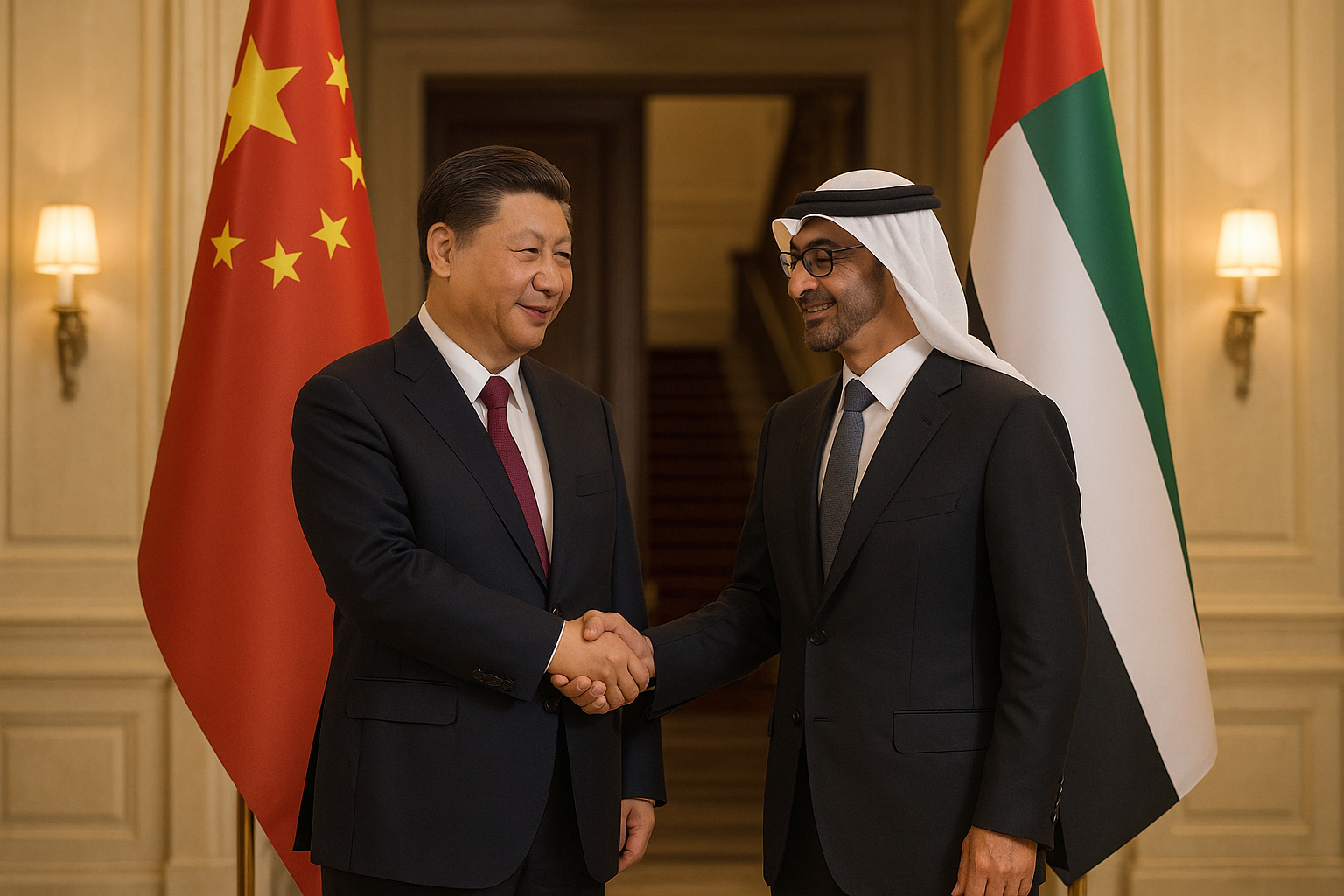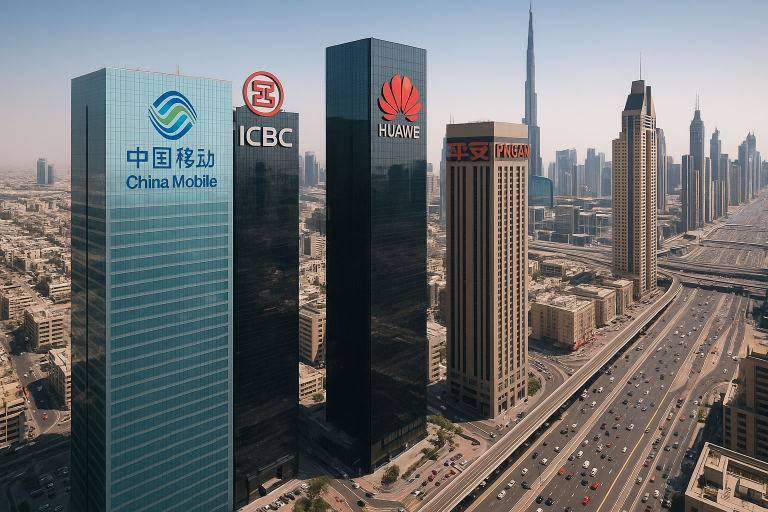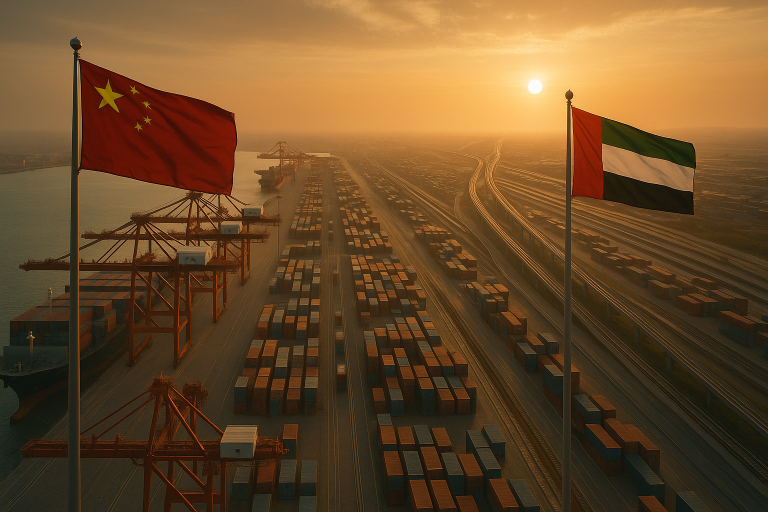Four Decades of Diplomatic Excellence: The Foundation of China-UAE Strategic Partnership
Introduction
As 2024 marks the 40th anniversary of the establishment of diplomatic relations between the People’s Republic of China and the United Arab Emirates, it offers a moment for reflection on a partnership that has blossomed from a nascent connection into a comprehensive strategic alliance of global significance. What began as a forward-thinking diplomatic overture in 1984 has evolved into a multifaceted relationship characterized by deep political trust, staggering economic growth, and vibrant cultural exchange. The journey of China-UAE relations is a compelling narrative of two nations, with distinct histories and cultures, finding common ground and building a future of shared prosperity. This partnership, now elevated to a “Comprehensive Strategic Partnership,” stands as a testament to the power of visionary leadership and a shared commitment to development, innovation, and a more balanced global order. This article will trace the remarkable trajectory of this relationship, exploring the key historical milestones that laid its foundation, celebrating the tangible achievements of the current era, and looking ahead to the vast opportunities that await in the next chapter of this exemplary partnership.
Historical Context: The Genesis of a Powerful Alliance
The formal establishment of diplomatic relations on November 1, 1984, was a deliberate and visionary act. For the UAE, a young nation founded in 1971, it was part of a broader strategy to forge a diversified network of international partnerships. For China, then in the early stages of its reform and opening-up policy, it represented a crucial step in building bridges with the Arab world and the Gulf region. The early years were foundational, focused on building the institutional architecture of the relationship. A significant step was the opening of the UAE Embassy in Beijing on March 19, 1987, which provided a permanent channel for dialogue and cooperation. These initial decades were marked by a steady, incremental strengthening of ties, laying a groundwork of mutual respect and understanding.
A pivotal turning point arrived in January 2012 with the establishment of a “Strategic Partnership.” This move signaled a mutual recognition that the relationship had matured beyond conventional diplomatic and trade ties. It was an acknowledgment of the growing strategic alignment between the two countries on regional and international issues and a commitment to elevate cooperation to new heights. This strategic partnership created the framework for more ambitious collaborations, particularly in the fields of energy, finance, and infrastructure.
The relationship entered a “golden era” in July 2018, when Chinese President Xi Jinping paid a historic state visit to the UAE—the first by a Chinese head of state in 29 years. During this landmark visit, the two nations agreed to upgrade their ties to a “Comprehensive Strategic Partnership.” This elevation was more than symbolic; it represented a commitment to all-encompassing, multi-layered cooperation across virtually every field. It solidified the UAE’s position as one of China’s most important partners in the Middle East and set the stage for an unprecedented acceleration in joint initiatives, from the Belt and Road Initiative to space exploration.
Key Milestones in China-UAE Diplomatic Relations
November 1, 1984 – Formal establishment of diplomatic relations.
March 19, 1987 – Opening of the UAE Embassy in Beijing.
January 2012 – Establishment of the Strategic Partnership.
July 2018 – Elevation to a Comprehensive Strategic Partnership during President Xi Jinping’s state visit.
2024 – Celebration of the 40th anniversary of diplomatic relations.
Current Achievements: A Partnership Delivering Tangible Results
The Comprehensive Strategic Partnership is not merely a political declaration; it is a dynamic framework that has yielded substantial and tangible benefits for both nations. The depth of the partnership is most evident in the frequency and warmth of high-level diplomatic exchanges. President His Highness Sheikh Mohamed bin Zayed Al Nahyan has visited China multiple times, a clear indicator of the personal commitment of the UAE’s leadership to the relationship. These visits have been reciprocated by a steady stream of high-level Chinese officials to the UAE, including Premier Li Qiang in September 2024 and Foreign Minister Wang Yi in March 2021, ensuring that the strategic vision is consistently translated into action.
This strong political trust has enabled the two countries to align their efforts on the global stage. Both China and the UAE are staunch advocates for multilateralism, sustainable development, and a more inclusive system of global governance. Their mutual support within international organizations like the United Nations has amplified their collective voice on critical global issues. This alignment is further strengthened by the UAE’s role as a key partner in the Belt and Road Initiative (BRI). The UAE was one of the first countries to embrace the BRI, recognizing its potential to drive economic development and enhance global connectivity. Its strategic location and world-class infrastructure have made it an indispensable hub for the BRI, serving as a critical gateway for Chinese trade, investment, and logistics connecting Asia with the Middle East, Africa, and Europe.
In a signed article published in the Emirati media ahead of his 2018 visit, President Xi Jinping described the state of the relationship: “Thanks to the strategic partnership, our bilateral cooperation has embarked on a fast track and our relations are in their best shape ever.” [1]
This sentiment is backed by concrete achievements. The partnership has fostered a level of economic interdependence that is remarkable in its scale and scope. Bilateral trade has soared, and investment flows are diversifying into high-tech, future-oriented sectors. The success of this partnership demonstrates a new model of international relations, one based not on coercion or temporary alignment, but on a long-term vision of shared growth and mutual benefit.
Success Stories: Milestones of a Flourishing Partnership
The strength of the China-UAE partnership is best illustrated through specific, transformative milestones that have marked its recent history.
Case Study 1: President Xi Jinping’s 2018 State Visit
President Xi’s 2018 visit was a watershed moment. The elevation to a Comprehensive Strategic Partnership was accompanied by the signing of 13 agreements and memoranda of understanding covering a vast array of sectors, from e-commerce and energy to agriculture and customs cooperation. A key outcome was the deepening of cooperation under the Belt and Road Initiative, with both sides committing to enhance policy coordination and project development. During the visit, President Xi was conferred with the Order of Zayed, the UAE’s highest civil decoration, a gesture that symbolized the deep respect and appreciation for his role in strengthening the bilateral relationship. This visit laid out a clear and ambitious roadmap for the future, the positive effects of which are still unfolding across the economic and political landscape.
Case Study 2: The UAE’s Accession to BRICS
In 2023, the UAE officially became a member of the BRICS group, an influential bloc of major emerging economies comprising Brazil, Russia, India, China, and South Africa. China was a vocal and steadfast supporter of the UAE’s membership, recognizing the value of including a dynamic and globally connected economy within the group. The UAE’s accession is a significant strategic achievement. It provides the nation with a powerful platform to advocate for the interests of emerging economies, enhances its influence in global economic governance, and opens up new avenues for trade and investment with a market of over 3 billion people. For the China-UAE partnership, it creates another important forum for strategic coordination and collaboration on a global scale.
Case Study 3: Comprehensive Mutual Visa Exemption
While economic and political agreements form the backbone of the partnership, the decision to implement a comprehensive mutual visa exemption policy, effective January 16, 2018, has been one of the most impactful measures for the people of both nations. The UAE became the first country in the Middle East to have such an arrangement with China. This policy has been a tremendous catalyst for tourism, business travel, and cultural exchange. It has made it easier for Chinese tourists to experience Emirati hospitality, for business leaders to explore opportunities, and for students and families to connect. This single act has done more to foster people-to-people understanding than years of formal diplomacy, creating a foundation of grassroots friendship that will sustain the partnership for decades to come.
Future Opportunities: Charting the Course for the Next 40 Years
As China and the UAE look to the future, their partnership is poised to expand into new and exciting frontiers. Their shared vision is increasingly focused on the high-tech, knowledge-based economy of the 21st century. There is immense potential for deeper collaboration in sectors such as artificial intelligence, where both countries have ambitious national strategies. Joint research and development in areas like machine learning, smart city applications, and data analytics can position them at the forefront of the digital revolution. Space exploration is another promising area, building on existing cooperation to potentially include joint missions and the sharing of satellite data and technology. Furthermore, as global leaders in the energy transition, the two nations are set to deepen their partnership in renewable energy, moving beyond solar power to pioneer developments in green hydrogen and other clean energy solutions.
In this evolving landscape, the UAE China Chamber of Commerce (UECN) is set to play an even more critical role. As the primary platform for business-to-business engagement, the UECN is indispensable for companies seeking to navigate the opportunities of the next decade. It provides the market intelligence, networking opportunities, and practical support that businesses need to forge successful partnerships and capitalize on the strategic alignment between the two governments. The Chamber will be instrumental in connecting innovators, entrepreneurs, and investors, driving the next wave of economic growth that will define the future of the China-UAE relationship.
Conclusion: A Partnership Built on Trust, Delivering Prosperity
The journey of China-UAE relations over the past four decades is a powerful story of what can be achieved when two nations commit to a partnership based on mutual respect, strategic foresight, and a relentless pursuit of win-win cooperation. From its modest beginnings in 1984, the relationship has grown into a comprehensive strategic partnership that is a model for the region and the world. It is a partnership that has not only delivered immense economic prosperity, with trade and investment reaching unprecedented levels, but has also fostered deep political trust and vibrant cultural ties.
The success of this relationship is rooted in a set of core principles: a respect for each other’s sovereignty and development path, a focus on common interests, and a shared belief in an open and inclusive global economy. As they celebrate 40 years of diplomatic excellence, China and the UAE are not just looking back at their achievements; they are looking forward to a future of even greater collaboration. Their partnership, built on a solid foundation of trust, is poised to continue delivering prosperity for their people and contributing positively to regional stability and global development for the next 40 years and beyond.
References
[1] Xinhua. (2018, July 19). Full text of Chinese President Xi’s signed article on UAE media. Retrieved from http://www.xinhuanet.com/english/2018-07/19/c_137335232.htm







